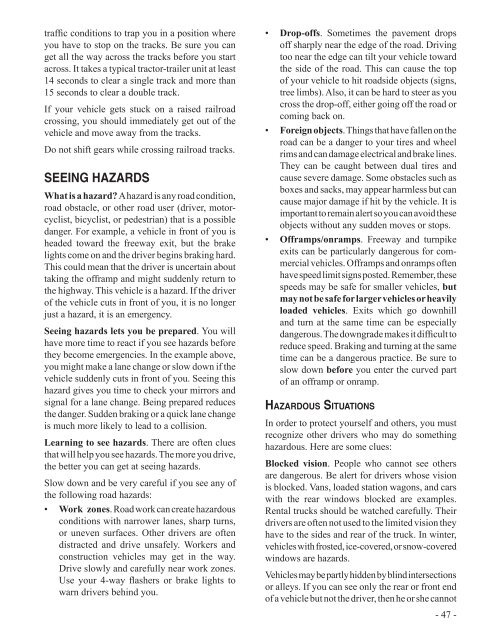Commercial Driver Handbook ( PDF ) - California Department of ...
Commercial Driver Handbook ( PDF ) - California Department of ...
Commercial Driver Handbook ( PDF ) - California Department of ...
Create successful ePaper yourself
Turn your PDF publications into a flip-book with our unique Google optimized e-Paper software.
traffic conditions to trap you in a position where<br />
you have to stop on the tracks. Be sure you can<br />
get all the way across the tracks before you start<br />
across. It takes a typical tractor-trailer unit at least<br />
14 seconds to clear a single track and more than<br />
15 seconds to clear a double track.<br />
If your vehicle gets stuck on a raised railroad<br />
crossing, you should immediately get out <strong>of</strong> the<br />
vehicle and move away from the tracks.<br />
Do not shift gears while crossing railroad tracks.<br />
SeeIng hAzARDS<br />
What is a hazard? A hazard is any road condition,<br />
road obstacle, or other road user (driver, motorcyclist,<br />
bicyclist, or pedestrian) that is a possible<br />
danger. For example, a vehicle in front <strong>of</strong> you is<br />
headed toward the freeway exit, but the brake<br />
lights come on and the driver begins braking hard.<br />
This could mean that the driver is uncertain about<br />
taking the <strong>of</strong>framp and might suddenly return to<br />
the highway. This vehicle is a hazard. If the driver<br />
<strong>of</strong> the vehicle cuts in front <strong>of</strong> you, it is no longer<br />
just a hazard, it is an emergency.<br />
Seeing hazards lets you be prepared. You will<br />
have more time to react if you see hazards before<br />
they become emergencies. In the example above,<br />
you might make a lane change or slow down if the<br />
vehicle suddenly cuts in front <strong>of</strong> you. Seeing this<br />
hazard gives you time to check your mirrors and<br />
signal for a lane change. Being prepared reduces<br />
the danger. Sudden braking or a quick lane change<br />
is much more likely to lead to a collision.<br />
Learning to see hazards. There are <strong>of</strong>ten clues<br />
that will help you see hazards. The more you drive,<br />
the better you can get at seeing hazards.<br />
Slow down and be very careful if you see any <strong>of</strong><br />
the following road hazards:<br />
• Work zones. Road work can create hazardous<br />
conditions with narrower lanes, sharp turns,<br />
or uneven surfaces. Other drivers are <strong>of</strong>ten<br />
distracted and drive unsafely. Workers and<br />
construction vehicles may get in the way.<br />
Drive slowly and carefully near work zones.<br />
Use your 4-way flashers or brake lights to<br />
warn drivers behind you.<br />
• Drop-<strong>of</strong>fs. Sometimes the pavement drops<br />
<strong>of</strong>f sharply near the edge <strong>of</strong> the road. Driving<br />
too near the edge can tilt your vehicle toward<br />
the side <strong>of</strong> the road. This can cause the top<br />
<strong>of</strong> your vehicle to hit roadside objects (signs,<br />
tree limbs). Also, it can be hard to steer as you<br />
cross the drop-<strong>of</strong>f, either going <strong>of</strong>f the road or<br />
coming back on.<br />
• Foreign objects. Things that have fallen on the<br />
road can be a danger to your tires and wheel<br />
rims and can damage electrical and brake lines.<br />
They can be caught between dual tires and<br />
cause severe damage. Some obstacles such as<br />
boxes and sacks, may appear harmless but can<br />
cause major damage if hit by the vehicle. It is<br />
important to remain alert so you can avoid these<br />
objects without any sudden moves or stops.<br />
• Offramps/onramps. Freeway and turnpike<br />
exits can be particularly dangerous for commercial<br />
vehicles. Offramps and onramps <strong>of</strong>ten<br />
have speed limit signs posted. Remember, these<br />
speeds may be safe for smaller vehicles, but<br />
may not be safe for larger vehicles or heavily<br />
loaded vehicles. Exits which go downhill<br />
and turn at the same time can be especially<br />
dangerous. The downgrade makes it difficult to<br />
reduce speed. Braking and turning at the same<br />
time can be a dangerous practice. Be sure to<br />
slow down before you enter the curved part<br />
<strong>of</strong> an <strong>of</strong>framp or onramp.<br />
hazardous situations<br />
In order to protect yourself and others, you must<br />
recognize other drivers who may do something<br />
hazardous. Here are some clues:<br />
Blocked vision. People who cannot see others<br />
are dangerous. Be alert for drivers whose vision<br />
is blocked. Vans, loaded station wagons, and cars<br />
with the rear windows blocked are examples.<br />
Rental trucks should be watched carefully. Their<br />
drivers are <strong>of</strong>ten not used to the limited vision they<br />
have to the sides and rear <strong>of</strong> the truck. In winter,<br />
vehicles with frosted, ice-covered, or snow-covered<br />
windows are hazards.<br />
Vehicles may be partly hidden by blind intersections<br />
or alleys. If you can see only the rear or front end<br />
<strong>of</strong> a vehicle but not the driver, then he or she cannot<br />
- 47 -

















